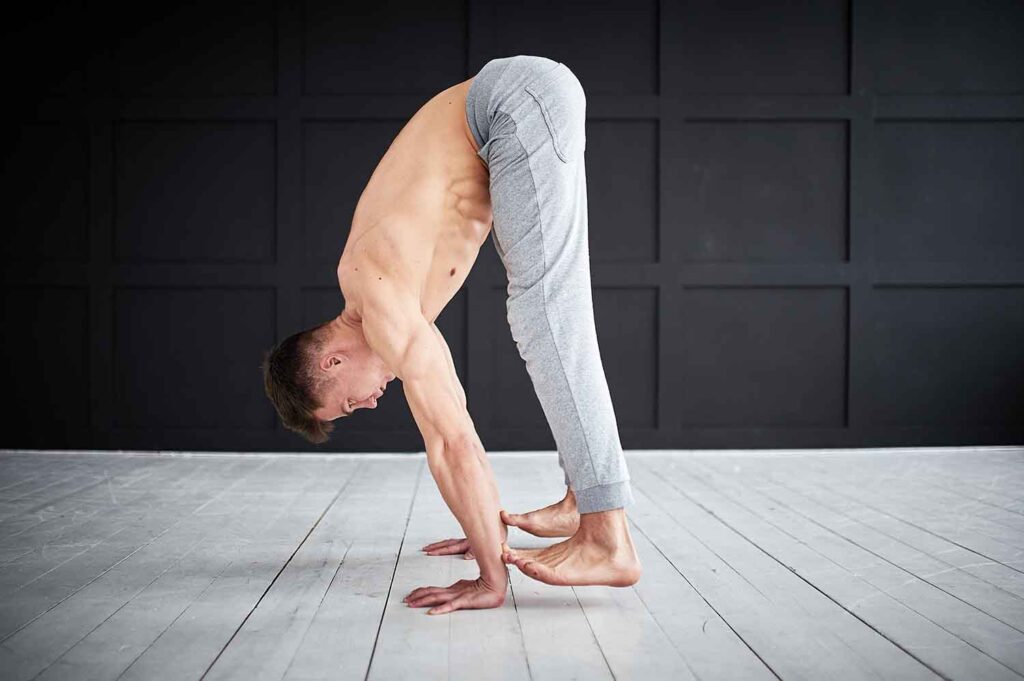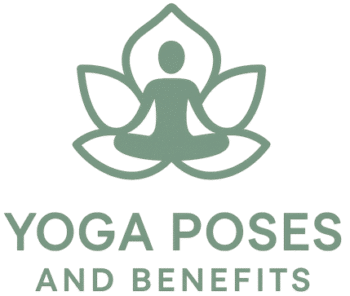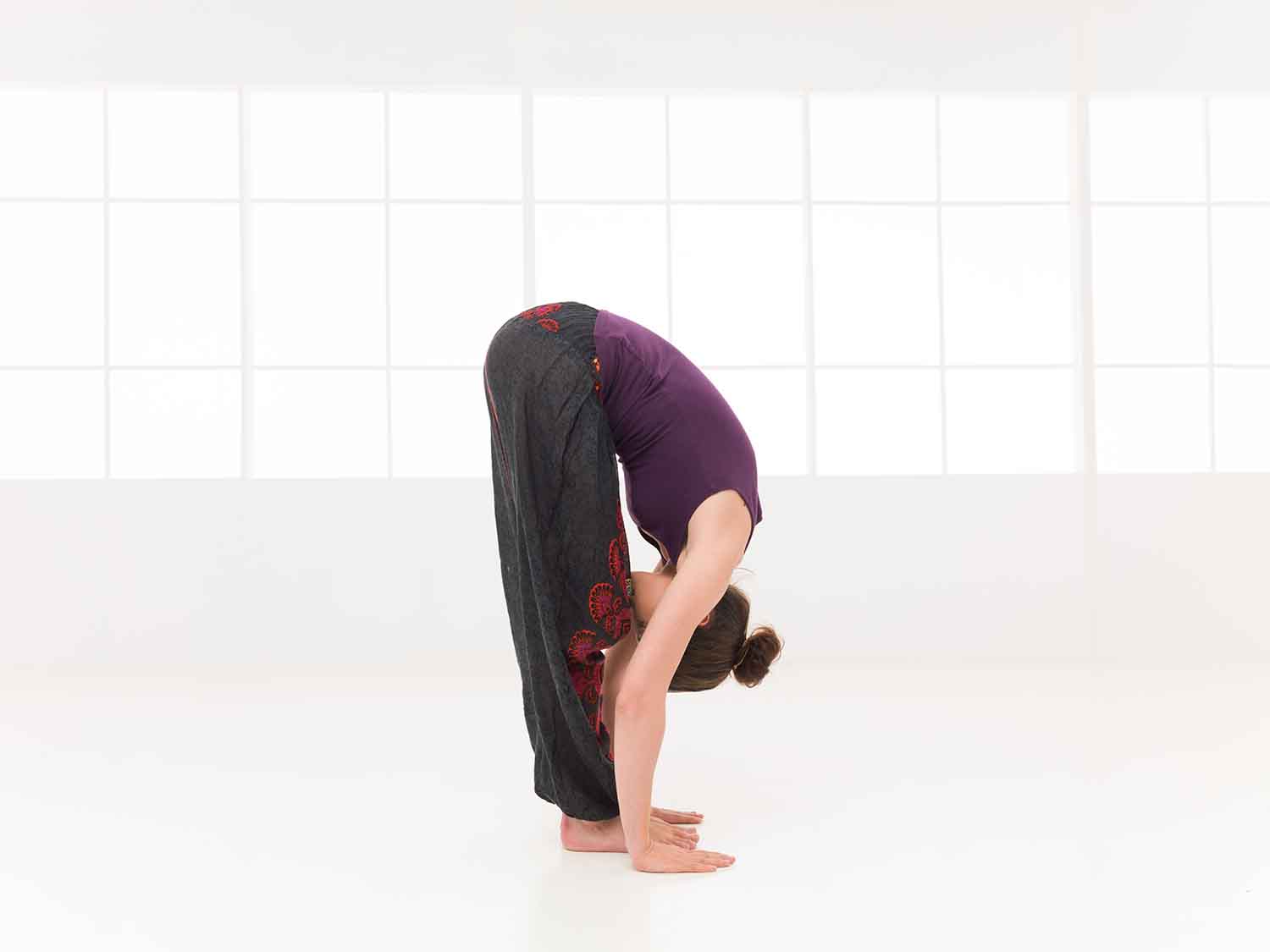Standing Forward Bend pose in yoga (Uttanasana) is a fundamental yoga posture that stretches the entire back of the body, from the spine to the hamstrings and calves. This pose is ideal for improving flexibility, calming the mind, and relieving tension in the back. It is often incorporated into sequences as a transitional pose but also serves as a powerful way to connect breath with movement.
Other Names for Standing Forward Bend Pose in yoga
Here are some of the common names for Standing Forward Bend in yoga:
- Uttanasana (Standing Forward Bend)
- Standing Forward Fold
- Forward Fold Pose
How to Do Standing Forward Bend in Yoga
To perform Standing Forward Bend, follow these steps:
- Begin by standing tall in Tadasana (Mountain Pose), with your feet hip-width apart and your arms relaxed by your sides.
- On an inhale, lengthen your spine and reach your arms overhead.
- As you exhale, hinge at your hips and slowly fold forward, bringing your chest toward your thighs. Allow your arms to dangle or place your fingertips on the mat, shins, or ankles.
- Keep a slight bend in your knees to avoid straining your lower back or hamstrings. Let the crown of your head release toward the floor, and relax your neck.
- Engage your core to support the fold and deepen the stretch along the back of your legs.
- Hold the pose for several breaths, allowing gravity to deepen the stretch. To exit, slowly roll up to standing, stacking each vertebra one at a time.
Variations of Standing Forward Bend
There are several variations of Standing Forward Bend to suit different needs and levels of flexibility:
- Hands-to-Elbows Fold: Instead of letting your arms dangle, clasp opposite elbows with each hand. This variation provides a more relaxed fold, allowing for a deeper stretch in the back.
- Deep Uttanasana: For more advanced practitioners, deepen the stretch by placing your palms flat on the floor, with or without bending the knees. This increases the intensity of the stretch in the hamstrings and calves.
- Standing Forward Bend with a Twist: Place one hand on the floor and twist your torso to one side, extending the opposite arm toward the ceiling. This adds a spinal twist to the forward bend, promoting flexibility and balance.

Modifications for Standing Forward Bend
Standing Forward Bend can be modified to accommodate different levels of flexibility and strength:
- Bend the Knees: If your hamstrings are tight, bend your knees as much as necessary to keep the spine long and avoid rounding the back. This makes the pose more accessible and reduces strain on the lower back.
- Use a Block: Place a block under your hands for added support, especially if you can’t reach the floor comfortably. This helps maintain alignment while allowing you to benefit from the stretch.
- Hands on Thighs or Shins: If bending all the way forward is too intense, rest your hands on your thighs or shins for support. This modification reduces the depth of the fold while still providing a stretch.
Contraindications for Standing Forward Bend in Yoga
While Uttanasana has many benefits, it’s important to be cautious in certain situations:
- Back Injuries: If you have any existing back injuries or lower back pain, avoid rounding the spine and focus on lengthening the torso. You may also want to use modifications, such as keeping the knees bent or using a block for support.
- Hamstring Injuries: Practitioners with hamstring issues should bend their knees generously to avoid aggravating the injury.
- High Blood Pressure: Those with high blood pressure should avoid holding the pose for an extended period or practice a gentler forward fold with the head higher than the heart.
- Pregnancy: Pregnant practitioners should avoid compressing the abdomen and can modify the pose by using a wider stance or keeping the hands on blocks or thighs for support.
Tips to Improve Standing Forward Bend in Your Practice
To deepen and improve your experience in Uttanasana, consider these helpful tips:
- Engage the Core: Drawing the navel in toward the spine helps protect the lower back and maintain a long, stable posture.
- Breathe into the Fold: Use your breath to guide the movement. With each inhale, lengthen the spine, and with each exhale, fold deeper, allowing gravity to help you release further into the pose.
- Shift the Weight Forward: Distribute your weight evenly between the balls of your feet and your heels to maintain balance and avoid overloading the heels or lower back.
- Relax the Neck: Allow the head to hang freely, releasing tension from the neck and upper back. Avoid any unnecessary tension in the jaw or shoulders.
- Use Props: Incorporating blocks or a yoga strap can help create more space in the fold while maintaining proper alignment.
What Muscles Does Standing Forward Bend Work?
Standing Forward Bend engages and stretches a variety of muscle groups, offering a full-body stretch:
- Hamstrings: The primary stretch occurs in the hamstrings, which run along the back of the thighs. Uttanasana helps lengthen and release tension in these muscles.
- Calves: As the heels press into the mat, the calf muscles are gently stretched, improving flexibility in the lower legs.
- Lower Back: The lower back muscles are lengthened and stretched, relieving tension and promoting a healthier spine.
- Glutes: Bending forward also engages the gluteal muscles, helping to stretch and release tightness in the hips.
- Spine (Erector Spinae): The entire length of the spine is lengthened, providing relief to the muscles that support the back and improving posture.
Mental and Emotional Benefits of Standing Forward Bend in Yoga
In addition to its physical benefits, Uttanasana provides several mental and emotional advantages:
- Calming the Mind: The forward-folding motion encourages a calming effect on the mind, helping to reduce stress and anxiety. It’s often used in sequences to transition into a more introspective, meditative state.
- Promoting Mindfulness: Holding the pose and focusing on the breath cultivates awareness and mindfulness, bringing practitioners into the present moment.
- Releasing Tension: By stretching the back of the body and the spine, Standing Forward Bend can relieve physical tension, which often leads to emotional release.
- Encouraging Restfulness: Uttanasana is known to have a soothing effect on the nervous system, promoting a sense of calm and preparing the body for relaxation or sleep.
Is Standing Forward Bend Suitable for Beginners?
Yes, Standing Forward Bend is accessible to beginners with the right modifications:
- Start with Bent Knees: Beginners should focus on keeping the knees bent and the spine long, prioritizing the fold from the hips rather than reaching the floor.
- Use a Block or Chair: Practicing with hands resting on a block or the seat of a chair can help beginners maintain proper alignment while still experiencing the benefits of the stretch.
- Gentle Approach: For those new to yoga or tight in the hamstrings, a gentler approach can prevent overstretching and encourage safe progression over time.
Is Standing Forward Bend Suitable for Advanced Practitioners?
Advanced practitioners can take Uttanasana to a deeper level by adding variations or enhancing awareness:
- Deepen the Fold: With greater flexibility, advanced yogis can work on straightening the legs fully and placing the palms flat on the floor, or even grasping the ankles or calves to deepen the fold.
- Add Twists or Binds: Advanced variations, such as twisting the torso or binding the arms behind the back, add complexity and increase the stretch along the spine and shoulders.
- Hold Longer: Practicing longer holds with controlled breath can challenge balance and flexibility, allowing practitioners to explore the deeper benefits of the posture.
How Does Standing Forward Bend Contribute to a Yoga Sequence or Flow?
Standing Forward Bend is a versatile posture that fits well into many yoga sequences:
- Transition Pose: Uttanasana is commonly used as a transitional pose, moving between standing postures, forward bends, and Sun Salutations. It helps to reset the body and focus the breath.
- Cooling Posture: As a calming and introspective pose, Uttanasana can be included toward the end of a sequence to wind down the body and prepare for more restful postures, such as seated stretches or Savasana.
- Posture for Balance: Incorporating Standing Forward Bend after a challenging standing or balancing sequence can help rebalance energy and stretch the legs, relieving tension and preparing the body for further movement.
How Can I Deepen My Practice in Standing Forward Bend?
To deepen your experience in Uttanasana, consider these strategies:
- Engage the Thighs: Activating the quadriceps and drawing the kneecaps up will help protect the hamstrings and create a more stable base for the pose.
- Focus on the Hips: Instead of collapsing forward, hinge at the hips and draw the torso closer to the thighs with control. This improves alignment and ensures a safe fold.
- Breathe Mindfully: Lengthen the inhale to extend the spine and use the exhale to deepen the forward fold. This rhythmic breathing helps deepen the posture gradually and safely.
- Add Props: Incorporating a strap around the feet can provide extra leverage for deepening the stretch without straining the back or hamstrings.
What Are Some Common Mistakes in Teaching Standing Forward Bend?
Common mistakes in teaching Standing Forward Bend Pose (Uttanasana) can limit the effectiveness and safety of the posture. Addressing these issues ensures a better experience for students:
- Rounding the Back: A common mistake is allowing students to round their upper or lower back, which strains the spine. Encourage them to hinge from the hips, not the waist, and focus on lengthening the spine forward before folding.
- Locking the Knees: Many students may hyperextend or lock their knees, which can lead to discomfort or injury. Remind them to keep a micro-bend in the knees to protect the joints and engage the leg muscles.
- Forcing Depth: Some students may try to force themselves deeper into the pose, compromising alignment. Instruct them to prioritize length in the spine over how far they fold, and to listen to their body without pushing past its limits.
- Neglecting the Core: Not engaging the core can lead to collapsing into the pose, reducing support for the lower back. Encourage students to activate their core muscles to support the spine and maintain control throughout the fold.
- Inadequate Weight Distribution: Students often shift their weight too far back into the heels, which creates imbalance and tension. Guide them to balance the weight evenly between the front and back of the feet for a more stable, grounded stance.
- Tension in the Neck and Shoulders: Many students hold unnecessary tension in their neck and shoulders. Encourage them to relax the head, allowing it to hang naturally, and release tension in the shoulders.

